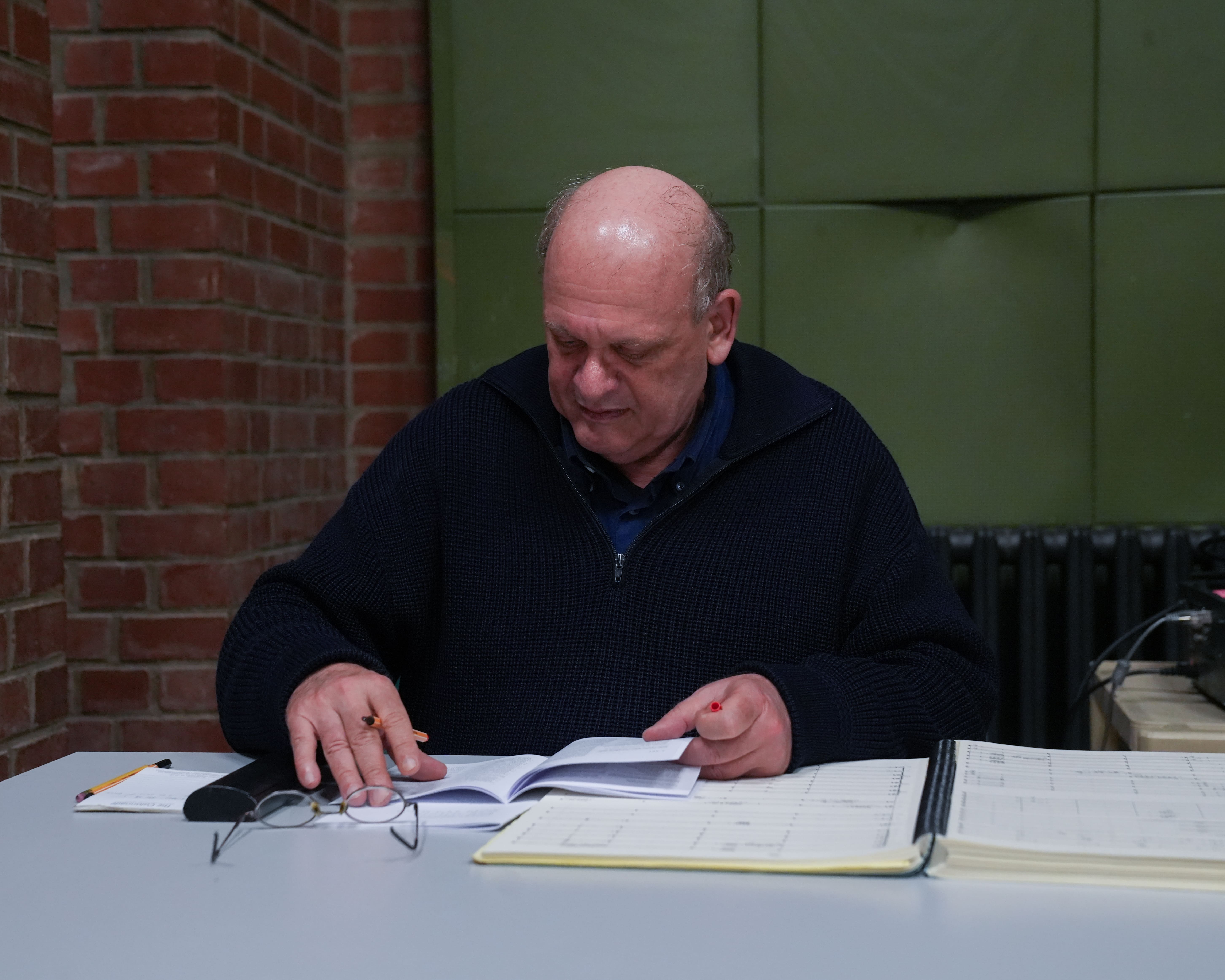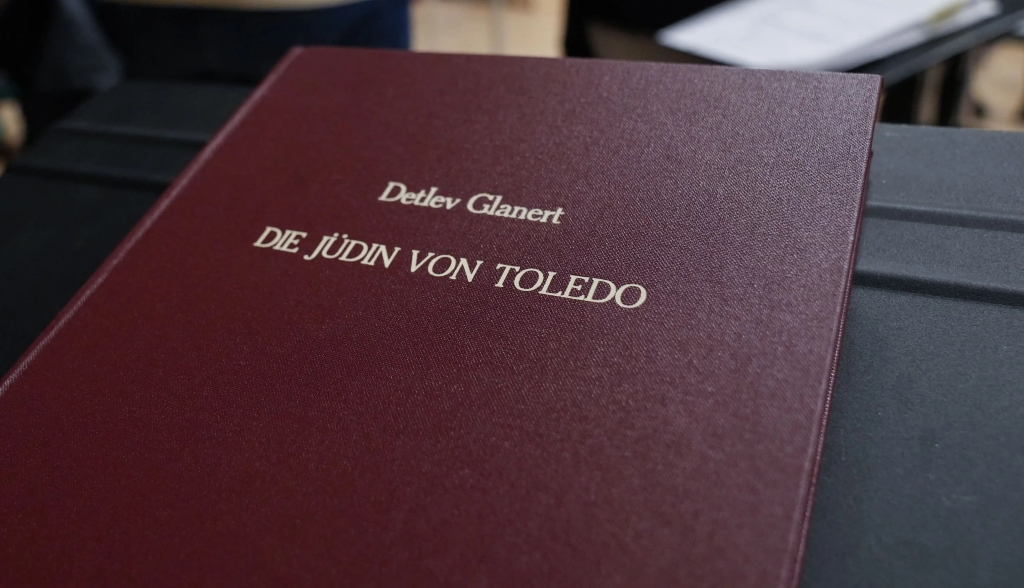Ten questions for composer Detlev Glanert on the occasion of the world premiere of his opera “The Jewish Woman from Toledo” on February 10, 2024, at the Semperoper, Dresden.*
👉🏻 Read the full review here.
Mr. Glanert, thank you for finding a time for this interview on your premiere day. How do you feel, and what do you do on a day like this?
I feel a restless nervousness. I can’t do anything and can’t work. I meet friends and answer countless emails or WhatsApp SMSs. At the same time, I’m trying to clean up my apartment because I’m generally departing the next day. I ensure that my premiere attire fits and that I don’t step on anyone’s feet on stage or fall over the cable. I’m trying to let go. You can compare it to a birth act. You worry about a child who has not yet been born. Only after the performance has begun and after the curtain falls will it be possible to determine whether it is breathing. Whether it survived or not.

Detlev Glanert. ©Nadja Möller
How long does the process of creating or composing an opera take from the first to the last, the premiere day?
It’s a very long process. My first opera, “The Mirror of the Great Emperor,” took fourteen years. In ” The Jewish Woman from Toledo,” six years. Once you have found a material, you look for a librettist. Once you’ve found one, the work on a scenario begins. A process that can take up to two and a half years. After the scenario is finished and approved, the first concrete sounds appear. I write these down and, as in the case of “The Jewish Woman from Toledo,” present them to my librettist Hans-Ullrich Treichel. Then, we gradually work through all five acts. During this process, I begin from the beginning. The first changes are taking place, and so on. You could compare it to about fifteen grand tours on the bike. Working on the score takes around 18 months. The entire piece construct is repeatedly checked and, if necessary, optimized. Then, it is compared again, agreed upon, rewritten, and optimized, if necessary, and so on. Therefore, an opera’s composition represents a long-lasting, challenging, recurring reflection, evaluation, and optimization process.

Let’s talk about the ” The Jewish Woman from Toledo,” which may be an involuntary, realistic plot. Did you intend to be political? Did you have Dresden, the city of a challenging social and political life, in mind?
All the subjects I deal with are only of interest to me because they concern me today. Be it social, political, or emotional in nature. I prefer historical materials because they are more decipherable. Today’s materials are still too moving and have no expiry date. On the other hand, the themes from the past function paradigmatically almost exemplary. In this opera, we experience the cramming of the three religions together, which, from a dramaturgical perspective, forms the basis for a conflict that I consider of high political actuality. Namely the interference of politics in private life and the functionalization of existing prejudices for political purposes. When I began to write the opera, I honestly didn’t have Dresden on my mind, but the Semperoper. Due to the current political situation, the production has suddenly gained an additional volatile external context. Of course, I am aware of the right-wing radical tendencies in Saxony and some other federal states in Germany. But after careful consideration, opera intendant Peter Theiler and I agreed to choose this theatre play precisely as everyone agreed it corresponds perfectly with the artistic visions of the Semper Oper.
What interested you personally about this story?
One thing that interested me was the constellation of the power struggle between the king and the queen and Rahel being an involuntary victim. The king is weak, like a pennant determined by the winds. The queen, on the other hand, is ruthless and the only one who knows what she wants. She is “The Putin” in this game, who does everything to preserve the power. Another constellation that interested me was the relationship between two sisters. Rahel and Esther love each other dearly but differ in their personalities fundamentally. Rahel is a 17-year-old naive, funny, posh girl who wants to enjoy life. While Esther is not only older but much more experienced. To protect her younger sister, she takes on the role of a warner, a fortune teller, and, ultimately, a prophet.
In opera, it often happens that the female protagonist (almost) always must die at the end. It’s no different in your opera.
Women die in the opera because they are not only portrayed as victims but because they often are victims. At the beginning of the opera, it is unforeseeable that the king’s young mistress would have to die. She falls head over heels in love with the king, and both enjoy a promising love experience at the first site. Nonetheless, the situation is unfavorable for both as, considering the given circumstances, this love had no chance of surviving.
6. Is there any (missionary) message in this opera? Any answers to possible audience questions?*
We learn about a story, about a particular personal fate presented to us on stage by singers wearing make-up and costumes and acting amongst the scenery. All that happens on stage is directed to make us reflect. What is fascinating about the opera genre is that, as highly intellectual adults, we negotiate ourselves through the witnessed stage actions. True after Schiller: The playing child is divine. In the opera we can act as a reflective adults and thrilled children at the same time. A process that could be described as an appeal or an evocation, which in turn can raise questions. The answer, however, must be found in people’s minds. The core message, however, is: Come in, experience, reflect, and talk about it!

How would you describe the work with Robert Carsten, the singers, and the production team? Are you satisfied with the result? Does it reflect your expectations?
Working together on the first presentation of the newly composed opera is incredibly intense. There is constant communication with the stage director and conductor, beforehand meetings, and talking a lot on the phone. We review the score, clarify the details, improve, rewrite where needed, etc. The final main work takes place during rehearsals that last five to six weeks. Throughout this time, further adjustments are worked out, including choosing the only one right artistic decision out of about 1.8 million. Adapting the score to the scenic situations or adjusting selected singing passages to the vocal individualities of the soloists continues. My score becomes red from top to bottom. That is normal. This is part of the creation process that lasts until the premiere.
We talked about working on the presentation of the newly composed opera as an intense creative process and teamwork. Did the stage directors’ personal plot ideas change your perception of your work? Did you experience surprises or disappointments?*
In opera, directors can do whatever they see fit, provided they treat the score respectfully. There is some unwritten basic agreement. At the same time, it is clear to Hans-Ulrich Treichel, the librettist, and me that every director has a different idea and perception of the piece, and we accept that from the onset. This kind of teamwork sometimes bears unexpected turns and surprises. But what fascinates me most about composing an opera is that sometimes, some things don’t come out as I imagined. But when they are out, they might turn out to be just the ones I could have imagined myself.
You have a considerable portfolio of compositions of diverse genres. Is or was there a piece that has never been performed and which you would have liked to be performed?
All my works were performed except for a few from my youth. But there are a few compositions where I would have liked them to be performed more. For example, my Cantata based on Mörike poetry for tenor solo, mixed choir, and orchestra. Jonas Kaufmann performed it when he was young tenor. I still consider this Cantata one of my most beautiful works, which, unfortunately, is no longer performed.
Your other opera, Oceane, represents, in terms of composition, an impressive network of emotional dynamics, dense sound coloring, and a challenging but singable vocal score. The “The Jewish Woman from Toledo” orchestra score seems to be painted in all shades of black. If you had to begin with composition today, would you have turned away from this Francisco Goyaesque coloring of the score and done it differently?
I wrote Oceane around 2015/2016. This is now more of a thing of the past. I have always been interested in the black color in Spanish culture. For example, in the Escorial, Charles IV and Phillip II lived between Masses and in Bible reading. A strange, dark existence. The color scheme of the “The ” is utterly different. I imagine Toledo in 1195 to be much blacker, and this color finally becomes visually perceptible. In three years, I will become a different person. The new materials and texts may change my visual perception of colors and influence my compositions. One of my principles remains firm: I insist that my operas and music must continue to be an emotional experience.
*This is a transcript of the interview held together by Oxana Arkaeva for ProÒpera and Claudia Irle-Utsch of the Jüdische Allgemeine Zeitung. Corresponding common questions are marked with an (*) asterisk.